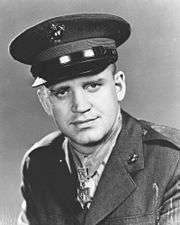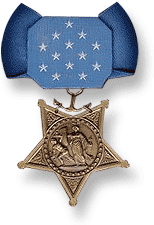Raymond G. Murphy
| Raymond Gerald Murphy | |
|---|---|
  Raymond G. Murphy, Medal of Honor recipient | |
| Nickname(s) | "Jerry" |
| Born |
January 14, 1930 Pueblo, Colorado |
| Died |
April 6, 2007 (aged 77) Pueblo, Colorado |
| Place of burial | Santa Fe National Cemetery Santa Fe, New Mexico |
| Allegiance |
|
| Service/branch | United States Marine Corps |
| Years of service | 1951–1959 |
| Rank | Captain |
| Unit | 1st Battalion, 5th Marines |
| Battles/wars | Korean War |
| Awards |
Medal of Honor Silver Star Purple Heart Medal Combat Action Ribbon |
| Other work | Veterans Administration, counselor |
Captain Raymond Gerald "Jerry" Murphy (January 14, 1930 – April 6, 2007) was the 39th United States Marine to receive the Medal of Honor for heroism in the Korean War. He was decorated by President Dwight D. Eisenhower in a White House ceremony on October 27, 1953. He earned the Nation's highest military decoration for heroic action for valor in the "Reno-Vegas" fighting of February 1953.
Biography
Raymond Gerald Murphy was born in Pueblo, Colorado on January 14, 1930 to Thomas and Mame Murphy. He graduated from Pueblo Catholic High School in 1947. He attended Fort Lewis Junior College in Durango, Colorado for two years before transferring to Adams State College in Alamosa, Colorado. While in college, he played varsity football, basketball and baseball, and worked as a swimming instructor in Durango in the summer of 1950. In 1951, Murphy graduated from Adams State College with a degree in physical education. He joined the Marine Corps Reserve in May 1951 and entered Officers Candidate School at Parris Island, South Carolina, the following month.
Commissioned a second lieutenant in September 1951, he was then ordered to Officers' Basic School at Quantico, Virginia. Completing the course the following February, he was transferred to Camp Pendleton, California, for advanced training before embarking for Korea in July 1952. In Korea, 2dLt Murphy served with the 5th Marines, 1st Marine Division until he was wounded in the action where he earned the Medal of Honor. After treatment aboard the Danish hospital ship Jutlandia, the American hospital ship Repose, and later in Japan, he was returned to the U. S. Naval Hospital, Mare Island, California, in March 1953. He was promoted to first lieutenant that same month.
He returned to Pueblo after his discharge from the hospital and was released from active duty April 7, 1953. On October 27, President Dwight Eisenhower presented Murphy and six others with the Medal of Honor during a ceremony at the White House. He is one of four Medal of Honor recipients from Pueblo, Colorado, the others being William J. Crawford, Drew Dennis Dix, and Carl L. Sitter.[1] Murphy was promoted to captain on December 31, 1954 and discharged from the Marine Corps Reserve five years later on December 28, 1959.
After the war, Murphy moved to New Mexico. From 1974 until his retirement, he worked as a counselor for the Veterans Administration and became the Chief of Veterans Services. After retiring from the VA Jerry stayed on as a volunteer at the hospital until 2005. He and his wife, Maryann, raised three sons, John, Tim, and Michael, and a daughter, Eleanor.
Murphy died on April 6, 2007 in the Veterans Administration Nursing Home in Pueblo at age 77, after a long illness. He was buried at Santa Fe National Cemetery in Santa Fe, New Mexico.
Prior to his death, a bill was introduced in the U.S. Senate to name the Veterans' hospital in Albuquerque the Raymond G. Murphy Department of Veterans Affairs Medical Center.[2][3] The bill was passed by both houses of Congress and signed by President Bush on July 5, 2007.
Military decorations and awards
Capt. Murphy's military awards include:
| Purple Heart Medal | ||
| National Defense Service Medal | Korean Service Medal with two bronze service stars | United Nations Service Medal |
Medal of Honor citation
The President of the United States in the name of The Congress takes pleasure in presenting the Medal of Honor to
SECOND LIEUTENANT RAYMOND G. MURPHY
UNITED STATES MARINE CORPS
for service as set forth in the following
CITATION:
For conspicuous gallantry and intrepidity at the risk of his life above and beyond the call of duty as a Platoon Commander of Company A, First Battalion, Fifth Marines, First Marine Division (Reinforced), in action against enemy aggressor forces in Korea on February 3, 1953. Although painfully wounded by fragments from an enemy mortar shell while leading his evacuation platoon in support of assault units attacking a cleverly concealed and well-entrenched hostile force occupying commanding ground, Second Lieutenant MURPHY steadfastly refused medical aid and continued to lead his men up a hill through a withering barrage of hostile mortar and small-arms fire, skillfully maneuvering his force from one position to the next and shouting words of encouragement. Undeterred by the increasing intense enemy fire, he immediately located casualties as they fell and made several trips up and down the fire-swept hill to direct evacuation teams to the wounded, personally carrying many of the stricken Marines to safety. When reinforcements were needed by the assaulting elements, Second Lieutenant MURPHY employed part of his Unit as support and, during the ensuing battle, personally killed two of the enemy with his pistol. When all the wounded evacuated and the assaulting units beginning to disengage, he remained behind with a carbine to cover the movement of friendly forces off the hill and, though suffering intense pain from his previous wounds, seized an automatic rifle to provide more firepower when the enemy reappeared in the trenches. After reaching the base of the hill, he organized a search party and again ascended the slope for a final check on missing Marines, locating and carrying the bodies of a machine-gun crew back down the hill. Wounded a second time while conducting the entire force to the line of departure through a continuing barrage of enemy small-arms, artillery and mortar fire, he again refused medical assistance until assured that every one of his men, including all casualties, had preceded him to the main lines. His resolute and inspiring leadership, exceptional fortitude and great personal valor reflect the highest credit upon Second Lieutenant MURPHY and enhance the finest traditions of the United States Naval Service.
/S/ DWIGHT D. EISENHOWER
See also
References
- Inline
- ↑ Roper, Peter (August 30, 2010). "State Fair salutes soldiers and airmen". The Pueblo Chieftain. Pueblo, Colorado. Archived from the original on August 30, 2010.
- ↑ "Section 49, United States Senate". The Congressional Record. April 12, 2007. Retrieved 2007-05-24.
- ↑ Rick Maze (May 23, 2007). "Congressional feud ties up bill to honor vet". Marine Corps Times. Retrieved 2007-05-24.
- General
 This article incorporates public domain material from websites or documents of the United States Marine Corps.
This article incorporates public domain material from websites or documents of the United States Marine Corps.
- "Captain Raymond G. Murphy, USMCR". Who's Who in Marine Corps History. History Division, United States Marine Corps. Retrieved 2007-10-27.
- "2dLt Raymond G. Murphy, Medal of Honor, 1953, 1/5/1, Korea (Medal of Honor citation)". Marines Awarded the Medal of Honor. History Division, United States Marine Corps. Archived from the original on 2007-03-05. Retrieved 2006-06-27.
- "Living Medal of Honor recipients". Congressional Medal of Honor Society. Retrieved 2006-06-27.
- Roper, Peter (April 4, 2007). "Gentle hero, Raymond 'Jerry' Murphy dead at 77". The Pueblo Chieftain. Archived from the original on 2007-09-28. Retrieved 2007-04-08.
External links
- "Stories of Valor: Raymond G. Murphy, American Valor". PBS. Retrieved June 27, 2006.